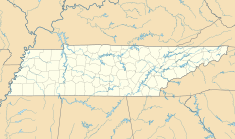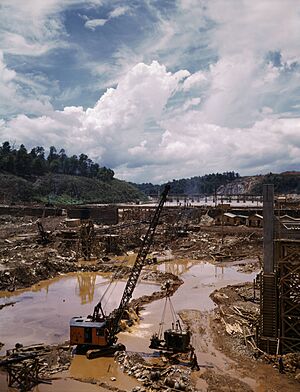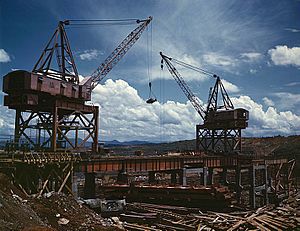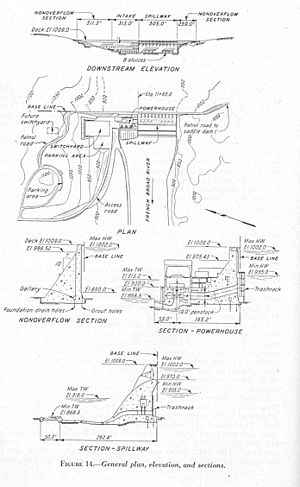Douglas Dam facts for kids
Quick facts for kids Douglas Dam |
|
|---|---|
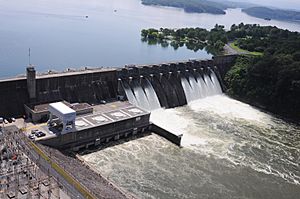
Douglas Dam from downstream
|
|
|
Location of Douglas Dam in Tennessee
|
|
| Official name | Douglas Dam |
| Location | Sevier County, Tennessee, United States |
| Coordinates | 35°57′40″N 83°32′20″W / 35.96111°N 83.53889°W |
| Construction began | February 2, 1942 |
| Opening date | February 19, 1943 |
| Operator(s) | Tennessee Valley Authority |
| Dam and spillways | |
| Impounds | French Broad River |
| Height | 202 feet (62 m) |
| Length | 1,705 feet (520 m) |
| Reservoir | |
| Creates | Douglas Lake |
| Total capacity | 1,461,000 acre⋅ft (1,802,000 dam3) |
| Catchment area | 4,541 sq mi (11,760 km2) |
| Power station | |
| Commission date | 1942–1954 |
| Turbines | 2 × 41 MW, 2 × 32 MW Francis-type |
| Installed capacity | 146 MW |
Douglas Dam is a huge hydroelectric dam on the French Broad River in Sevier County, Tennessee. It's operated by the Tennessee Valley Authority (TVA). The TVA built this dam super fast in the early 1940s. They needed it to make lots of electricity for World War II.
Douglas Dam is 1,705 feet (520 meters) long and 202 feet (62 meters) high. It creates a large lake called Douglas Lake. The dam was named after Douglas Bluff, a big cliff that was near the construction site.
Contents
Where is Douglas Dam?
The French Broad River flows west from the Appalachian Mountains. It gets bigger after other rivers join it. Eventually, it meets the Holston River near Knoxville, Tennessee to form the Tennessee River. Douglas Dam is about 32 miles (51 km) upstream from where the French Broad River joins the Holston River.
The area around the dam is where the Great Smoky Mountains foothills meet the Ridge-and-Valley Appalachians. Douglas Lake covers parts of Sevier, Jefferson, Hamblen, and Cocke counties.
You can get to the dam by Tennessee State Highway 338. This road crosses just below the dam. Interstate 40 (Exit 407) is also just a few miles north. The dam does not have any special locks for boats to pass through.
Building a Dam in Record Time
In 1941, President Franklin D. Roosevelt asked for money to build a dam on the French Broad River. After the Japanese attack on Pearl Harbor, the United States entered World War II. Building this dam became super important. It was needed to create hydroelectric power for national defense. Factories needed huge amounts of electricity to make aluminum and magnesium. These metals were vital for building warplanes.
At first, a U.S. Senator named Kenneth McKellar didn't want the dam built. He worried it would flood about 40 square miles (100 square kilometers) of good farmland. This land was important for the local food canning industry. Senator McKellar stopped the project for two months. But the country's need for electricity during the war was too great.
The government predicted that factories would need even more power by 1943. So, Congress approved the dam project in January 1942. President Roosevelt signed the bill into law on January 30, 1942.
Construction started right away on February 2, 1942. It was a rush job! Workers used plans, engineers, and machines from the nearby Cherokee Dam. That dam had just been finished a few weeks earlier.
Building Douglas Dam and its lake meant buying 33,160 acres (13,420 ha) of land. Over 5,000 acres (2,000 ha) of forest had to be cleared. Also, 525 families had to move, and 32 cemeteries were relocated. Many miles of roads had to be changed. The Smoky Mountain Railroad helped bring supplies to the dam site. They built a special railroad track to the area. This work actually saved the railroad from going out of business!
The Douglas Project also needed ten smaller, earthen dams. These are called "saddle dams." They fill in gaps along the hills to allow the lake to hold more water. Most of these are southeast of the main dam. One saddle dam protects the town of Dandridge, Tennessee. This town was originally going to be flooded by the lake. But the people of Dandridge asked First Lady Eleanor Roosevelt for help. They pointed out that Dandridge was the only place in the U.S. named after Martha Washington. Mrs. Roosevelt made sure a saddle dam was built to save the town from flooding.
Even with a four-week delay from flooding, Douglas Dam was finished very quickly. Its floodgates closed on February 19, 1943. This was just 382 days after construction began! This set a world record for a project of its size. The first electric generator started working on March 21, 1943. The second one started on January 1, 1944. The dam's powerhouse made electricity at full power for most of its first year. Douglas Dam provided power for two important war industries: aluminum production and the Manhattan Project's uranium enrichment at nearby Oak Ridge, Tennessee.
What Douglas Dam Does Today
The Douglas Dam powerhouse has four large water turbines. These turbines spin four big electric generators. Together, they can produce up to 146,000 kilowatts of electricity.
Besides making electricity, Douglas Dam has other important jobs:
- Flood Control: It helps control floods on the French Broad River and the Tennessee River. Douglas Lake can hold a lot of water, which helps prevent flooding downstream.
- River Navigation: During dry times, water is released from Douglas Lake and other dams. This keeps the Tennessee River deep enough for barges to travel. Without these releases, parts of the river would be too shallow for boats.
- Water Supply: The water released from the dam also helps provide drinking water for cities and towns downstream. It's also used to water farms during dry spells.
Douglas Lake is also a popular place for fun! Up to two million people visit it every year. People enjoy boating, swimming, and fishing. Many freshwater fish are caught in Douglas Lake, providing food. Douglas Lake has about 500 miles (800 km) of shoreline. Its surface area is nearly 30,000 acres (120 square kilometers). These numbers change depending on the water level.
You can go fishing, boating, water skiing, swimming, camping, hiking, and watching wildlife. The TVA has two public campgrounds near the dam. The Tennessee Wildlife Resources Agency adds tens of thousands of sauger and crappie fish to Douglas Lake each year. This helps keep the fish population healthy for fishing.
Helping the River's Health
Sometimes, hydroelectric dams can cause problems with oxygen levels in the water downstream. Douglas Dam uses three systems to help keep the water healthy:
- Turbine venting: This means injecting oxygen into the water as it goes through the water turbines.
- Surface water pumps: These pumps push oxygen-rich surface water down to the turbines.
- Water pulsing: This involves releasing water through the turbines now and then. It helps keep some water flowing downstream all the time.


